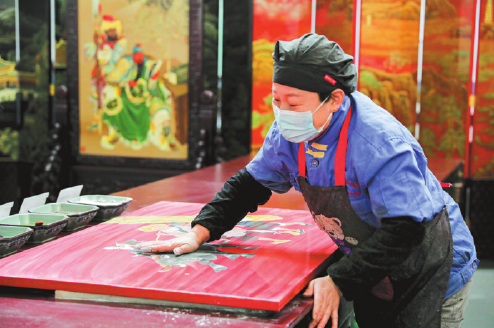Master craftsmanship wins county new honor
Updated: 2023-05-12

Pingyao's tuiguang lacquerware is renowned throughout the country for its high quality achieved through a hand-polishing technique. [Photo provided to China Daily]
Lacquerware and high-quality beef secure provincial title for Pingyao
The Shanxi county of Pingyao is known among tourists mostly because of its historical assets.
It boasts a centuries-old ancient city, surrounded by complete city walls and packed with old streets, blocks and structures. It was listed as a World Cultural Heritage Site by UNESCO in 1997.
Pingyao is also known as one of the hubs of the famed Shanxi merchants, who are said to have dominated business circles in North China during the Ming (1368-1644) and Qing (1644-1911) dynasties.
However, the local residents have other things to be proud of, for instance, the craftsmanship embodied in the production of hand-polished lacquerware and high-quality beef with ancient techniques.
The techniques for Pingyao's hand-polished – or tuiguang – lacquerware made the national list of intangible cultural heritage in 2006. Those for beef production were included on the same list in 2008.
The two products won further recognition when Pingyao was included in the provincial list of characteristic towns for local specialty industries in September 2022.
Developing towns with characteristic industries is a new strategy in Shanxi, which aims to create economic engines that accelerate high-quality industrial growth locally.
Local officials and businesspeople said that the listing of Pingyao as a characteristic town shows both the cultural and economic values of the products have been endorsed by provincial authorities. Now they are making plans for better development of the two industries.
Xue Shengjin is a famed inheritor of Pingyao's hand-polished lacquerware. At the age of 86, he still operates a studio for this traditional art.
According to Xue, Pingyao's hand-polished lacquerware is one of the top four Chinese varieties. With a history of more than 2,000 years, it is a brilliant representation of the nation's craft.
He added that it is made of natural raw lacquer and is varnished by hand using a special technique.
As the creation of the artworks involve complicated techniques – ranging from embedding and sculpting to painting – a successful craftsman in hand-polished lacquerware needs decades of experience, concentration and an unfailing taste for aesthetics, Xue said.
Xue devotes much of his energy to passing down this art to younger generations. He has offered training to more than 200 apprentices. Some of his apprentices turned out to be prominent artists in this trade, including two national-level and five provincial-level masters.
Xue said he is happy that the industry is not only well preserved, but brings revenues, jobs and business opportunities to locals.
According to local statistics, Pingyao now has more than 160 businesses – including companies, studios and household mills – in the production of hand-polished lacquerware, creating jobs for more than 5,600 local people. The businesses produce more than 300,000 lacquerware items a year, with an annual combined sales revenue of 100 million yuan ($14.43 million).
Tangdu Tuiguang Lacquer Ware is the largest producer of lacquerware in Pingyao. Encouraged by the county's new status, the company has recently completed an expansion project, according to Lei Shujuan, an executive of the company.
"We have invested 123 million yuan in developing a lacquerware-themed cultural park in downtown Pingyao," Lei said. "This is a comprehensive facility including such operations as production, sales, exhibition, tourism, research and education."
As the lacquerware industry is closely associated with tourism, Lei said the park is expected to become a new destination in Pingyao.
"We have attracted a growing number of tourists these days," she said. "We hope Pingyao's lacquerware can be promoted to the world with more tourists coming."
Feng Yuquan, mayor of Pingyao, said the county government has plans to help the artworks go global.
"We have invited the country's renowned artists to design products meeting the aesthetics of international buyers," Feng said. "We are also planning for global promotional events in cooperation with China's overseas diplomatic missions."
Beef production in Pingyao is an industry with a scale even larger than lacquerware. A single company, Pingyao Beef Group, reported sales revenue of 710 million yuan in 2022, more than seven times that of the lacquerware industry.
Pingyao's beef has whetted people's appetite with its tender texture and rosy color. The use of traditional techniques, which highlight controlled ingredient selection and production processes, has made Pingyao beef nationally renowned.
The county is home to 22 large or medium-sized beef production enterprises and 24 smaller mills, with a total annual processing capacity of 32,000 metric tons.
Li Zengfu, board chairman of Pingyao Beef Group, said the listing of Pingyao as a characteristic town for beef production is a great opportunity. In terms of the industry's development, it can increase the influence of local products, strengthen local enterprises' innovation and expand marketing channels. Recently, the company is planning for substantial capacity expansion, he added.
According to Wei Jiangfeng, Party secretary of Pingyao, the county's beef industry is expected to realize a total annual output value of 3 billion yuan by 2025.
To reach this goal, the county has invested more than 2 billion yuan in developing a beef industry park with an area of 40 hectares.
"In this park, we will offer standardized production plants for local beef producers and help them modernize their operations by introducing advanced technologies and equipment," Wei said.
The official added that the scale of the lacquerware industry is expected to reach 500 million yuan in annual output value by 2025.
Bai Xuhong and Pei Yunfeng contributed to this story.



